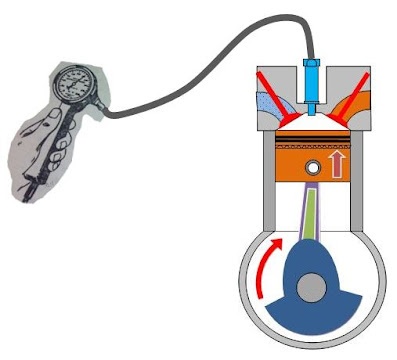A compression test is conducted to determine if the piston can compress the
air-fuel mixture in the cylinder to a specified pressure
which is essential for efficient combustion and maximum power output.
The compression test results are compared to the specifications. The
compression pressure specifications will be listed, for example, as 160 pounds
per square inch (psi), plus or minus 10 percent:
160 psi ± 10%
The plus or minus tolerance is an important part of the
specification since it limits the permissible variation between cylinder
pressures. Only when ALL the cylinder pressure readings are within the limits
of the specification, is smooth engine operation possible.
The figures in the chart table indicate and abnormally low reading
in cylinder No.1. A ten percent reduction in the reading of cylinder No.2 (160−16−144)
reveals that there is more than the permissible pressure variation between
cylinder No.1 and 2. The cause of the low pressure in cylinder No.1 must be
corrected before an effective tune-up can be performed.
|
COMPRESSION TEST RESULTS |
||||||
|
CYLINDER |
1 |
2 |
3 |
4 |
5 |
6 |
|
PRESSURE |
130 |
160 |
155 |
157 |
152 |
158 |
Fig . Compression test
If the compression builds up quickly and evenly to the specified
pressure on each cylinder and does not vary more than the allowable tolerance,
the readings are normal. The engine can be considered acceptable for tune-up.
Worn piston rings will be indicated by low compression on the
first stroke which tends to gradually build up on the following strokes.
A further indication is an improvement of the cylinder reading when
about a tablespoon of motor oil is added to the cylinder through the spark plug
hole with an oil can.
Valve trouble is indicated by a low-compression reading on the
first stroke and does not rapidly build up pressure with succeeding strokes.
The addition of oil will not materially affect the readings obtained.
Leaky head gaskets on two adjacent cylinders will produce the same
test results as valve trouble. An additional indication of this particular
trouble is the appearance of water in the crankcase.
Carbon deposits result in compression being considerably higher
than specified. It is possible that carbon can hide a defect in the cylinder,
as the deposit will raise the compression pressure of a cylinder to the extent
which might compensate for leakage






0 Comments
Please do not enter any spam link in the comment box.